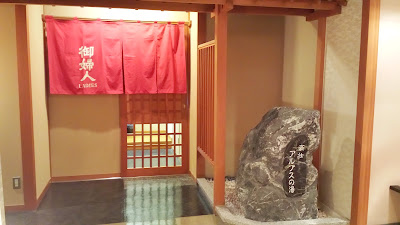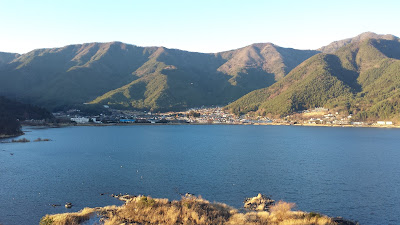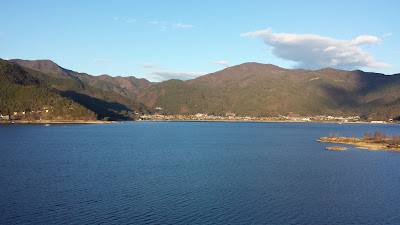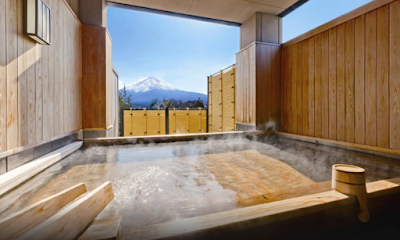In my last Japan Travel post, I highlighted our visit to see the Jigokudani Snow Monkeys famous for keeping warm and bathing in natural hot springs in part of the Japanese Alps. A few days after that day trip from Tokyo to the monkey hot springs, F and I headed to human hot springs in the mountains. Here’s a look at how I researched an onsen for us and where we stayed – Wakakusa no Yado Maruei by Mount Fuji.

In the early morning Wakakusa no Yado Maruei will swap the men and ladies’ indoor and outdoor onsen designations from the evening. So, there are a total of 4 onsen and you can experience 2 the first night and you can experience the other 2 (1 outdoor, 1 indoor) in the morning since they are always gender segregated.
Finding an Onsen Experience Right for You
First, a few definitions and traditions that you need to know as you are searching for an onsen to visit:
- Ofuro: a deep soaking tub and you usually do not change the water between people who use it (you usually use it one after another in the evening) because it takes so much water to fill, plus it’s more for relaxation than cleaning yourself as you need to wash before entering. Think of it sort of like a hot tub but without the bubbles and jets. Some ofuro are for one, but others can fit two people.
Ofuro in our room at Wakakusa no Yado Maruei - Sento: a public bathhouse with many ofuro, the water used may be heated tap water or hot spring water
- Onsen: a term meaning hot springs in Japan, aka the water is naturally heated from within the earth. Keep in mind that just because an onsen has the hot water doesn’t necessarily mean the bathtub itself is a natural hole in the ground, it includes man-made facilities that pump hot spring water into them.
- Rotenburo: a term meaning an outdoor hot spring bath, the tub may be natural (like a waterfall) or man-made with a view to natural surroundings and open to fresh air.

Example of the upstairs rotenburo at Wakakusa no Yado Maruei. When we checked in this was the rotenburo marked for women. Then by morning it had switched over so I was able to visit the other rotenburo which was smaller but had a direct view of Mount Fuji instead of of Lake Kawaguchiko like here. Photo from Wakakusa no Yado Maruei. I have a great memory of sitting in it alone shortly after a mother and her two kids had left so I had it to myself, and looking out into the lake and seeing a crane fly low, skimming over the water. This was the first onsen I went into and after that I got over the naked requirement because it was clear no one was looking or cared. - Ryokan: a traditional Japanese inn. They usually have tatami floors in the room and no bed as instead the staff will set up futon mattresses in the evening for guests to sleep. There are no chairs either – instead there will be a low table where you will kneel to enjoy tea or dine if meals are brought to your room. Many times onsens are offered by ryokan so that you can stay the night after your legs feel like jelly from all the soaking and relaxation.
At our ryokan Wakakusa no Yado Maruei, this is the main room after removing our shoes in the foyer and walking through our sliding door screen. You can see a little closet with onsen supplies (robes, a plastic bag for carrying things to the onsen rooms) on the left, and our private onsen with a view of a small rock garden and Mount Fuji to the back behind the glass, after the massage chair
- Yukata: a casual kimono robe where the left side is folded over the right and then the robe is tied closed with a sash. Many ryokan will provide yukata for their guests so you can change and stay in them, wearing the provided yukata and slippers wherever you go inside the Ryokan. The robes are unisex – just make sure to tie it with left over right as the opposite way is for the dead.
Us in our yukatas on the observation deck of Wakakusa no Yado Maruei – yes the yukatas were provided by the ryokan. I mapped it and from Wakakusa no Yado Maruei, a walk Mount Fuji is only 30 km away from here - Hot Spring Resort Town: This is an area that offer many facilities with onsen, and often you can visit multiple of these facilities as they are all part of a network for that town, traveling between each one in your yukata! Two famous resort town areas are Kurokawa Onsen (by Mount Aso, south of Fukuoka) and Kusatsu Onsen in Gunma (200 km north of Tokyo in the montains)
- Hot Spring Theme Park: Essentially a modern take of a Hot Spring Resort Town but built as a single large business instead of a destination of many cooperating businesses. Some parks are traditional like Ooedo Onsen Monogatari in Odaiba just outside Tokyo and Japan’s first hot spring theme park. Others are more themed and allow bathing suits and have specialty baths like Hakone Kowakien Yunessun/Mori-no-Yu that offers green tea spa, coffee spa, and wine spa (Seriously! You can see photos of these on Atlas Obscura); and meanwhile Spa World in Osaka recreates hot springs from around the world in its amusement park.
Onsen are a huge popular activity in Japan, and has been part of Japanese culture for a long time as individual homes did not use to have individual ofuro. So people went to a communal public bath to not only wash but also socialize. Ok technically, the washing happens individually at small stations with faucets and a hand held shower head and a stool for sitting along with provided soap and shampoo products, which you see to the right of the photo below. Then the socializing happens while soaking in the shared tubof some sort (natural or man made) after cleaning yourself. This is still true today – I saw families staying here for mother / daughter and also small groups of girlfriends who came and enjoyed onsen, chatting while relaxing in the hot water.

One of the indoor onsen I visited during my stay at Wakakusa no Yado Maruei. When we checked in this indoor onsen on the first floor was for women and there was another indoor one for men. Then by morning it had switched over so I was able to visit the other indoor one previously marked for men- it was even nicer because it was styled as an indoor waterfall, and also had an additional mineral bath onsen and a sauna. Photo from Wakakusa no Yado Maruei.
Meanwhile, the sento that are still in business, since ofuro are more common in homes, are now upgraded by often adding minerals or infusions to their tap water, or additionally having saunas, massages, and other spa services available (one example I considered was Spa LaQua in Tokyo Dome City open 22 hours a day- there’s a great blog entry about it by GaijinPot).
It is totally possible to visit and enjoy a relaxing hot bath wherever city you are staying as there is so much volcanic activity in Japan (doh, islands formed by such activity) that there are literally thousands of establishments with access to water heated naturally by the earth.
The questions you need to ask yourself in choosing your onsen experience are
1. How long do you want to stay? It is totally possible to visit some onsen as part of a day trip where you do not spend the night, such as at the Hot Spring Theme Parks (some outside Tokyo and also Osaka), or by using day passes you purchase at some Onsen. There are some where instead of bathing, you can just soak your feet for a partial experience via foot bath called ashiyu. You can find ashiyu in a variety of places, including even in public parks, airports (example: Kagoshima) and trains like the Yamagata Line Shinkansen.
On the other hand, devoting a whole day to the onsen experience will give you the full relaxation that will help you understand why onsen are so important and popular in Japanese culture that they love even bathing at home in the ofuro to get their fix until they can go to an onsen.
2. Will you be ok being naked? Most onsen are segregated by male / female, and you must be naked – no bathing suits. If you don’t feel comfortable enough, then you may want to choose a Hot Spring Theme Park that allows bathing suits.
There are also a few that have co-ed onsen – if you are hoping to share the experience with your opposite ex partner you don’t necessarily need to seek the co-ed ones. Instead just rent a private onsen (usually if they are available, you can rent them by the hour). And, with the private onsen rental no one sees you naked except whoever you share the private rental with.

The private onsen that we rented for an hour at Wakakusa no Yado Maruei was less than $15 an hour for use by both of us. Photo from Wakakusa no Yado Maruei.
3. Finally, where do you want to be? You might browse based on looking for one that is within a day trip away from a major city you are in like Tokyo or Osaka. You could search based on a rotenburo view you want (such as a mountain, or the ocean, or forest and rivers, or of cherry blossom trees). Another filter might be because you want to try lots of different kind of onsen you would go progressive onsen visiting in a location that has multiple onsen in the same facility, or an onsen town.
One additional note: tattoos are still viewed as subversive in Japan. This is changing with newer generations but many Onsen ban tattoos. They may enforce this rule with no exception even though it’s clear you are not yakuza (Japanese gang members) or they may look the other way if no other patrons complain. One way to help this is to cover any visible tattoos with bandages, or inquire if the Onsen is strict with this rule.
Onsen by Mount Fuji
For us, the answers were that we wanted to stay overnight, we wanted a view of Mount Fuji, and we wanted a private ofuro or rotenburo with a view of Mount Fuji to enjoy as part of the room. I also looked for a ryokan that had multiple onsen on the property so I can experience different set ups, and a private onsen that we could rent just for the two of us. F has an upper arm tattoo he didn’t try to cover up, so the in room Onsen and time we rented at the private Onsen were his main experiences while I visited every one on property, so the in room and private ones were important criteria.
I found all of this with Wakakusa no Yado Maruei. As my previous spreadsheet planning post could probably help you guess, I totally used a spreadsheet to check off different amenities to compare them with the name, location, url, price, and various features of course. There’s a section at the end of this post of the websites I used for research.
The location of Wakakusa no Yado Maruei is technically alongside Lake Kawaguchi, but with Fujisan only 30 km away, it felt like we were only next door. After we arrived at the train station (Kawaguchi-ko Station), we followed instructions to go to the Information Center connected to it where the woman behind the desk called Wakakusa no Yado Maruei for us so they could get us using their shuttle. They run their shuttle so you use it to get to the train station after check out and they bring you to the ryokan for check in.
I was already super stoked even at the train station because the train you take to get here (Fujikyu Railway, not covered by JR pass) passes right by Mount Fuji: look at the view from the train window at the Fujisan stop (2 stops away), and at Kawaguchiko station when we got out! The stop in between Fujisan and Kawaguchiko is Fuji Q Highland – a roller coaster amusement park with Evangelion World, Thomas the Train land, and just a casual view of Mount Fuji. The train stop is closer to the park than even the handicapped parking spots for cars in amusement parks in the US.

When we checked in, we were asked what time slot we wanted our dinner brought to our room, and also what time slot we wanted for breakfast in a common room. The front desk is also where you can inquire about renting the private onsen. After checking in, they brought us to seated area with windows overlooking Lake Kawaguchiko and welcomed us with green tea and a tea snack.



Then, we were taken to our room and given a small tour of the room including showing us how we shelve our shoes to wear slippers, how the toilet room had slippers to change into (this was also true even of the public restroom in the ryoken – there were just washroom slippers awaiting anyone who went in), and where to get the yukatas and also our little plastic drawstring bags to carry the complimentary washcloth, hair brush, scrunchee, etc. to the onsen. In the back past the massage chair there was a 3 part wash area – a tiled room with a sink area, another tiled room with the ofuro tub you could fill with hot spring water and open the window into a rock garden area and a view of Mount Fuji, and one final tiled room with a shower. Here’s a look at the tatami floored traditional Japanese room.
After dinner, staff snuck in while we were at the private onsen and moved the table and set up our futon.

Going up to visit the observation deck (just one floor above the rotenburo floor) gives you a preview of what the rotenburo what the Lake Kawaguchiko view and the other rotenburo with the Mount Fuji view would be:



As you may have seen me mention above, there were 4 onsen available to visit at Wakakusa no Yado Maruei. They are divided by men and ladies – with each getting one indoor and one rotenburo for the evening, and then by morning they are swapped so you can visit the other two. When we checked in, the rotenburo for ladies was the Lake Kawaguchiko view and a marble indoor one, then in the morning the ones I visited for ladies was a rotenburo with the view of Mount Fuji and the indoor one featured a waterfall setting and also an additional mineral bath. Both the indoor ones also had a sauna room.

One of the rotenburo at Wakakusa no Yado Maruei – they have one with the Lake Kawaguchiko view that is larger, and then a smaller one with this seemingly insanely close to Mount Fuji view. Photo from Wakakusa no Yado Maruei
Part of the wonderful experience of the ryokan was also having our dinner in our room. In the next Travel Tuesday post I’ll show you what our traditional Japanese dinner was like, as well as our breakfast the next day.
Have you stayed at a ryokan before, or is staying at a ryokan or visiting an onsen on your bucket list? Would you ever visit an onsen town, or onsen theme park?
More Resources on Onsen and Ryokan
- List by Japan Guide of “best onsen” by prefecture
- The website I used to fill out my comparison sheets of onsens was Selected Onsen Ryokan where you can
- To search by area, you might consider also using filters at Japan Ryokan and Hotel Association’s website or at the website Japanese Guest Houses
- If you are just looking for onsen based on scenery, Japanican has a way to search based on your onsen level
Here’s a summary of my Japan Travel post series:
- Guide to Planning a Trip: Research
- Guide to Planning a Trip: Mapping
- Hagoita Ichi Winter Festival at Sensoji Temple, Japan
- Japanese Treats at Temples and Shrines
- Winter Illuminations in Tokyo (Winter Season – November – February!)
- Snow Monkeys in Hot Springs
- Onsen by Mount Fuji covers Onsen 101 and how we loved our stay at Lake Kawaguchiko
- Dining at a Ryokan a look at what a traditional dinner and breakfast might be during a ryokan stay
- Visiting Cup Noodles Museum in Yokohama (just outside Tokyo)
- Visiting Shin Yokohama Ramen Museum
- Kyoto Temples and Shrines (walking tour starting in Higashimaya with stops especially at Kiyomizudera Temple, Kodaji Temple, Heian Shrine)
- Kyoto Temples in Arashiyama
- Kyoto Tofu
- Kyoto Famous Sights of the Kinkakuji (The Golden Pavilion) and Fushimi Inari (Red Torii Gates)
- Famous Signs of Osaka and eating Osaka Food specialities like okonomiyaki, takoyaki and kushikatsu
- Visiting Himeji Castle, the famous white castle in Japan
- Fun at Japanese Cafes and More including Maid Cafe, Cat Cafe; theme parks of J World and Namja Town, a geeky stop at Kanda Myojin, and Ghibli Museum
- Japan Eating Checklist is my top 25 list of things to try to include as an eating experience when visiting Japan
- New Year’s in Japan: Oji Fox Parade, and some photos of a Meiji Shrine visit on New Year’s Day







